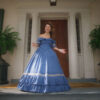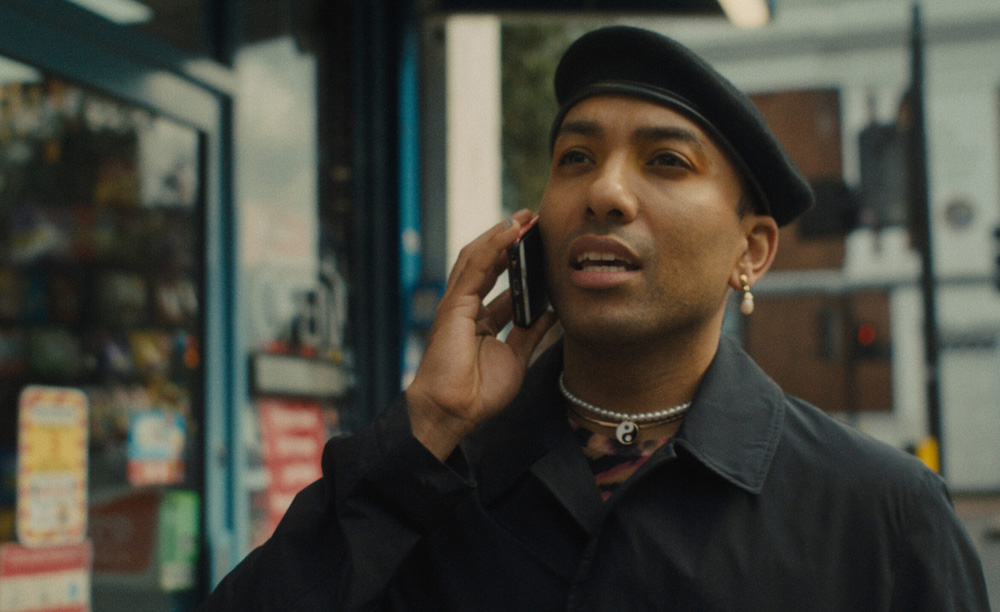Lewis (Keeran Anwar Blessie) doesn’t know exactly what he’s walking into at the start of “A Fox in the Night,” and it’s safe to say neither does the audience. As soon as the short begins, there is a surprise in store for anyone that thinks they’re a following militant Black man walking in the streets of England, donning a beret that is quickly revealed to be merely a stylish chapeau for a party he’s about to head to with his friend Harry, and he needs to pick up another accessory before they go from a local weed dealer named Daniel (Korey Ryan). Not one to typically deal with this responsibility, Lewis doesn’t necessarily know what to make of having to say the secret words at the doorway of the walkup apartment or how he fits into the space above where he has to wait his turn, wearing eyeshadow in the masculine space as other customers look for more at ease in the illicit operation. But when he has to stay an extra five minutes longer than he had planned, thanks to a ride share snafu, Lewis starts to think he may be in the right place rather than a dodgy part of town when Daniel actually strikes up a conversation with him, first taken aback by a question about what he’s wearing.
It isn’t only Lewis that is entering a whole new world, but the person playing him when Blessie is making his debut as a writer/director with “A Fox in the Night,” where any preconceived notions are quickly tossed aside once his leads make an unexpected connection. Unfolding on a balcony over the busy city streets, the film inspires curiosity about what other bonds are being prevented from occurring below when stereotypes have such a strong grip on people, though as Lewis and Daniel create the space to show each other a little tenderness, the possibilities seem endless and after being lauded at home where it picked up a London Critics Circle Film Award for Best British Short after premiering at BFI Flare last year, “A Fox in the Night” recently made its New York debut at Tribeca where Blessie was in town to talk about how he made the transition from being in front of the camera to behind it, subverting both cinematic tropes and societal ideas about masculinity and collaborating with his co-star Ryan.
I got inspiration for this story from a very good friend of mine who was dating somebody from the opposite end of the gender expression spectrum, and I was really fascinated by the relationship, so I started writing about these characters. I really wanted to tell a story of black joy and when I put these characters on paper, I [thought] “They seem to be locked in some kind of trauma exchange with the story, but I really don’t want to tell this story. Why is that?” And through that I started interrogating these characters a little bit more and realized that actually these two people have never had the 90s rom-com meet cute moment, so why not tell that story?
Had you planned on acting in this yourself? And how did you find Korey?
No, we were a completely independently funded film and I worked as an actor and I knew I wanted to try my hand at directing and writing, so I thought this is the adventure I’m going on and then my agent [said], “You have to act in it,” and I [thought], I don’t think I can wear all of these hats, but then with budget constraints, it was out of necessity that I took on the role. And it was through a casting process that we [found Korey]. It was an interesting journey because I wanted to cast as close as possible [to the person I knew], but at the same time, I didn’t want it to be revealed too quickly to the audience that there was an element of queerness, so we’d approached a wide range of actors and we actually were rejected by quite a lot of people once they read the script. I think a lot of black men just don’t want to be close to the material, [which was] unfortunate. And then we found Korey. He just walked in, he was so enthusiastic and so charismatic and so collaborative. It was a huge thing that I was looking for in somebody who was going to take part in the film and having all of that energy made it really exciting for me to work with him. And he is very easy on the camera. You just put a camera on him and there’s so much going on. It was a real luxury working with him.
Was there anything from your acting background you found useful as a director?
When I started this process, a friend of mine said, “At the end of the day, you’ve got to recognize what you come into the room with and that’s experience as an actor, so you know how to direct actors and you understand what that process is.” So I knew that what I had craved most was trust and the freedom to be creative and collaborative, but also having somebody who informed where the guardrails were so that I could play within a certain kind of space. I knew that I had to provide that for everybody who was performing in it and I did that in the rehearsal process, and then on the day, I really wanted to entrust everyone with a certain level of autonomy. I didn’t want to stifle anybody’s instincts on the day and they knew what they had to do. Obviously, if things go off-script, and it’s completely taking us off track of the story, it’s my job to rope everybody back in, but that was really an asset in being able to allow everyone to play to their strengths and it was really exciting to see people flourish. It’s so great being on the other side of the camera and watching takes [because], it is so exciting to see someone completely flourish and lean into what they’re good at. That’s really when magic happens.

I used to enjoy improvising, so we had a rehearsal where we’d analyze the text and we’d go through all of what was on the page and try to find the common ground that existed between us. The actual chemistry could live and breathe and it was really interesting because during those rehearsals, there were often suggestions from actors about word changes or things that felt a bit stilted for them. I was quite happy to have people make things feel as natural as possible, so that when we arrived on the day, the script was stuck to because it felt embedded in each player’s language.
That opening image really turns a certain idea on its ear about the kind of person you’re following. Was that in mind from the start?
Yeah, it was something that had come to me quite immediately. I picked that shot – not being able to see Lewis’s face for a very long time — because I wanted the audience to be able to have an opportunity to put on their own assumptions onto who the characterthey’re about to see and where they’re walking in an urban environment and what that means for them. I didn’t want to influence it too much by having my own opinion on the character revealed too early.
It’s also a lovely apartment overlooking that street. Was that difficult to find as a location?
It was a pure coincidence and such a luck because we had a different location in mind and that had fallen through, so we went back to the drawing board and somebody knew someone who shares the house as a location, so we were like, “Okay, let’s go and have a look.” And it just lent itself to the story. There were so many visually interesting things, and certainly constraints as well – it was Abbey Road, so we were contending with quite a lot [of traffic]. But it offered so much, and it’s very rare to find a balcony in London, but it was such a gift that we got to pay homage to to the classic “Romeo and Juliet” balcony scene. It was really beautiful that we could we have all those gifts that that space gave us.
What’s it been like to get this film out into the world?
It has been insane. My producer and I were chatting and it’s like the film almost dares us to take it a little step further each time because we did not expect this at all and it’s like the little film that could. It’s been such a wild, wonderful journey that I’m so, so grateful for and at times it feels like a complete anomaly, but it’s been a joy. I’ve just tried to be as present as possible for all of it and for me, being a director and writer was really a homecoming. It was the first time I was like, “Oh, this is where I need to be. This is where it feels right,” and that’s quite lovely when you connect to your purpose in that way. And this project has been so amazing because I’m just one small cog in a very big machine and I’ve worked with so many incredible collaborators and creative minds that have been so inspiring. That’s been the most exciting part is being able to play with others, and to create with others is such a joy. That’s the thing I most look forward to doing again.
“A Fox in the Night” will screen at Tribeca Festival on June 17th at 9 pm at the AMC 19th St. East and will be available to stream from June 19th through July 2nd via the Tribeca at Home app.





